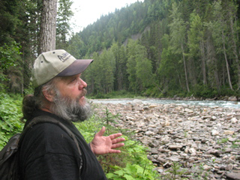
It's called the dirty Fraser in some parts of the province. But in the Rocky Mountains, before sand and silt colour it muddy brown, the Fraser River is a milky steel-blue and clean enough to drink.
At least so says Shawn Burleigh, our young rafting guide. He steers the raft with two long paddles, strong and steady, and patiently answers all our questions.
We've got many of them. Our group has been camped on the banks of the Fraser River not far from the town of Valemount, and within sight of the Mt. Robson glaciers that feed the huge river's source. We've been here two nights but this is our first time on the water. Today we'll spend a couple of leisurely hours on the raft with Burleigh.
Tomorrow we climb aboard our 34-foot canoe, the Cedar Spirit, and begin the first leg of our journey north down the Fraser River, from Tete Jaune through Dunster, McBride and Crescent Spur.
Rock flour, tiny particles from the rocks, give the river the colour of cartoon ice cubes, says Burleigh. In fact, he adds, people say the high mineral content can actually relieve constipation.
"Of course, you never do know what's upstream."
He's right in more ways than one. In terms of climate change, we don't know exactly what's coming down the chute at us.
Follow the Fraser further downstream and you'll find people along its route already feeling the foreshocks of climate change. This is especially true of those who make a living from the forests.
Warmer winters have allowed the mountain pine beetle to flourish in B.C. Like locusts making their way from field to field, from 1993 to 2006, beetles ate through 9.2 million hectares of B.C.'s pine forests -- an area as large as England.
Then the U.S. housing market crashed. Lumber giants Canfor and Weyerhauser started cutting shifts, then shutting down and closing their mills for good.
Last year alone an estimated 10,000 workers lost their jobs -- and communities are asking themselves, now what?
For middle-aged mill and forestry workers, early retirement or job training is an option, but for Burleigh's friends, guys in their early 20s, the dream is a well-paying job in the Alberta oilfields.
But in the fall, Burleigh will return to the College of New Caledonia's outdoor recreation and ecotourism program. His goal is to design a mountain-biking tour for people in wheelchairs so a paraplegic friend of his "will have something to do."
Tourism the next big thing?
For now, Burleigh says, he's having the time of his life rafting on the Fraser River. Floating in the shadow of Mount Robson, we look up at the glaciers from which this river springs, dazzling white against a blue sky. It's hard to imagine a better job than this. I understand why he wouldn't want to leave.
"So tourism might have to be the next big thing," says Burleigh. "If people out here rafting on the river are caring and not just trying to make money, then it would be pretty sustainable, I think. We could all be happy."
Roy Howard knows better than anyone how difficult it can be to reach that kind of happy, or at least friendly, compromise.
Howard has lived in Dunster for 33 years. In the late 1990s, as president of the Fraser Headwaters Alliance, he sat on the Robson Valley land use management committee. When yelling matches would break out between loggers and environmentalists, friends say Roy was the peacemaker to whom both sides would listen.
One of the most heated arguments was over logging near the Upper Goat River, a tributary of the Fraser about 35 kilometres northwest of McBride. Despite being identified as important habitat for the endangered bull trout and mountain caribou, as well as wolves, grizzlies, lynx and wolverines, the area received no special zoning under the region's land use management plan.
Intent on raising the profile of the Goat as one of the last pristine valleys in the region, Howard spearheaded the task of promoting it as a premier hiking destination in the province.
The Goat River Trail is a historic route from Barkerville to McBride via a pass in the Caribou Mountains. It was first cleared in 1886 by a crew of men under orders from Gold Commissioner John Bowron, though First Nations likely traveled this way long before they arrived.
We meet Howard at the confluence of the Goat and Milk Rivers, on an old forest service site northeast of West Twin Provincial Park. The Cedar Spirit is parked in a cutblock -- the only one so far in this valley -- where we've set up camp for the night. After three days paddling north, we will travel by van from here to Prince George, where the river curves like the top of an 'S' and heads south.
While we're here, Howard has agreed to lead our group down a 5-kilometre section of the Goat River trail to the first ford, where he and his son installed a cable car back in 2001.
"We got all kinds of shit from the Forest Service for building the cable car," he says, as we file along the narrow path that follows the river, flanked on either side by blueberry bushes and prickly devil's club.
Some of the locals weren't too happy about the trail promotion either, says Howard as he hacks at some overgrowth.
"Log it! There's no money in tourism, only logging. Tourism only pays eight dollars an hour for jobs, and there's not very many of them," Howard recalls hearing.
"It seems to me that's the minor part of it. It's the ecosystem protection you should be worried about."
How much is a forest worth?
Jobs in tourism will never replace those in the forestry industry. But in recent years, researchers in British Columbia have tried to put a dollar value on forests, not just trees.
We meet one of these researchers, Kyle Hillman, in a parking lot off Highway 16, about a hundred kilometres west of Prince George.
A plain and forgettable sign on the side of the road indicates the Ancient Cedar Forest is one kilometer ahead; what it should say is, "See a tree that's older than Christ!"
Hillman is counting the number of visitors that do pull off the highway to visit the Ancient Cedar Forest interpretive trail, and requesting they fill in a survey asking where they are from and why they have come.
"As you're coming along this road, you don't expect to see trees that magnificent a couple of hundred metres off the highway," says Hillman.
They are magnificent. We speak in hushed voices and walk on to the trail as though we're tourists in a cathedral. It feels like a holy place; it's dim and silent but for the occasional creaking of the treetops, some 50 meters high. The sweet musty smell of moist earth and cedar bark fills my nostrils.
The tallest cedar, Big Tree, is five metres in diameter. It's been growing in this spot for at least 1,500 years.
In 2005, University of Northern B.C. graduate student David Radies was doing random sampling for a lichen diversity study in the area when he saw logging tape tied around a red cedar that he estimated to be at least two thousand years old.
His hunch was correct. Radies had inadvertently discovered an ancient forest that was about to be logged. Such pockets of biodiversity comprise only about one per cent of the land base in the Robson Valley. Characterized by giant cedars and forms of lichen that have evolved together over thousands of years, they exist within the ordinary spruce and fir that cover the mountainous slopes of the valley.
Although this particular forest has been removed from the timber license, Radies fears that as logging operations move away from now-worthless pine stands and into sub-alpine regions, the ancient trees will be axed along with everything else and likely turned into fence posts, shingles or garden mulch.
"It's almost like a litmus test for how poor forestry is," says Radies. "With all of our fancy biodiversity literature that we have out there, we still continue to log these forests when there is such a low economic value."
"We do need to subsidize and diversify the forest economy. But we need to do it within the parameters of what can be supplied ecologically."
Researchers at the University of Victoria found that the value of forests is often greater than the value of clear-cut logging. Forests also serve as recreation sites, carbon storehouses and sources of products other than timber.
'Raise the level of discussion'
David Connell is an assistant professor at UNBC who is leading the study at the Ancient Cedar Forest. He says this work is part of a growing body of research that could be used for land management and planning purposes.
"It's an attempt to actually play the same game with the same rules," says Connell.
"Let's at least try to place a value on the things we can easily value, and raise the level of discussion. Then we can talk about global significance of conservation in ecological terms."
We leave the Ancient Forest Trail and hit the highway. Next stop is Prince George and then Soda Creek, where we will begin week two of the trip in a raft. The theme for this leg is salmon and riversheds.
In the Goat River, Howard told us how bears carry the salmon carcasses in to the forest where they rot, providing valuable nitrogen for the soil.
Salmon feed humans, too. We've all heard the gloomy stories of how stocks are declining. How is it affecting people who fish on the river? We're about to find out.
Next Wednesday: Following the embattled young salmon's journey down BC's mightiest river.
Related Tyee stories:
- Battling the Beetle
A Tyee series on the how BC can adapt to the bug's timber devastation - and avoid a repeat. - Who Will Revive BC's Forests?
World relies on our 'lungs,' but replanting is lowest in 20 years. - Rough Weather Ahead
A Tyee reader-funded series on how global warming will hit BC.
Read more: Labour + Industry, Environment
















Tyee Commenting Guidelines
Comments that violate guidelines risk being deleted, and violations may result in a temporary or permanent user ban. Maintain the spirit of good conversation to stay in the discussion.
*Please note The Tyee is not a forum for spreading misinformation about COVID-19, denying its existence or minimizing its risk to public health.
Do:
Do not: